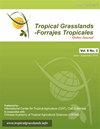紫靛作为印度尼西亚牛的优质饲料的潜在作用
IF 0.7
4区 农林科学
Q3 AGRICULTURE, DAIRY & ANIMAL SCIENCE
引用次数: 0
摘要
在印度尼西亚,养牛的主要是小农,他们严重依赖低质量的成熟草和作物残茬作为动物饲料。草料树豆科植物(FTLs)提供了一种实用和有利可图的选择,为限制牛生长和繁殖提供营养,特别是在干旱月份。蓝草(Indigofera zollingeriana)是一种高、高产的饲料植物,每68天采伐一次,可产生超过4吨干物质(DM)/公顷/收获的可食用植物材料。zollingeriana适应相对广泛的气候条件和土壤类型,对酸性土壤具有显著的高耐受性。饲料品质优良,粗蛋白质含量高(平均265 g/kg DM),纤维含量低(平均367 g中性洗涤纤维/kg DM), DM体外消化率高(72.6%)。它不含已知的抗营养化合物,但吲哚吡啶的浓度目前尚不清楚,吲哚吡啶是一种已知的有毒污染物,存在于某些种类的靛蓝中。关于动物对喂养佐林格氏单胞菌反应的信息有限,特别是对牛的反应,但研究表明,山羊的生长反应与其他可用的ftl相当。迄今为止的研究表明,佐林格氏滴虫可能是印度尼西亚目前可用的ftl的宝贵补充,特别是用于酸性土壤,但需要进一步了解在盐碱地上的表现、定期收获下的持久性、indospicine状态、牛的接受程度以及对其生产力的影响。本文章由计算机程序翻译,如有差异,请以英文原文为准。
The potential role of Indigofera zollingeriana as a high-quality forage for cattle in Indonesia
Ownership of cattle in Indonesia is dominated by smallholder farmers, who rely heavily on low-quality mature grasses and crop residues as animal feed. Forage tree legumes (FTLs) provide a practical and profitable option for supplying nutrients limiting cattle growth and reproduction, especially during the dry months. Indigofera zollingeriana is a tall, high-yielding plant under investigation as feed, which can produce edible plant material exceeding 4 t dry matter (DM)/ha/harvest, when cut every 68 days. I. zollingeriana is adapted to a relatively wide range of climatic conditions and soil-types, with notable high tolerance of acidic soils. Forage quality is high, with high crude protein (265 g/kg DM average) and low fiber (367 g neutral detergent fiber/kg DM) concentrations and high in vitro DM digestibility (72.6%). It contains no identified anti-nutritional compounds but concentration of indospicine, a recognized toxic contaminant in some species of Indigofera, is currently unknown. Information on animal responses to feeding I. zollingeriana is limited, especially for cattle, but research suggests growth responses in goats are comparable with those for other available FTLs. Research to date suggests I. zollingeriana could be a valuable addition to FTLs currently available in Indonesia, especially for acidic soils, but further information is required on performance on saline soils, persistence under regular harvesting, indospicine status, acceptance by cattle and effects on their productivity.
求助全文
通过发布文献求助,成功后即可免费获取论文全文。
去求助
来源期刊

Tropical Grasslands-Forrajes Tropicales
Agricultural and Biological Sciences-Agronomy and Crop Science
CiteScore
1.60
自引率
0.00%
发文量
36
审稿时长
16 weeks
期刊介绍:
The Journal publishes, in English or Spanish, Research Papers and Short Communications on research and development, as well as contributions from practitioners (Farmer Contributions) and Review Articles, related to pastures and forages in the tropics and subtropics. There is no regional focus; the information published should be of interest to a wide readership, encomprising researchers, academics, students, technicians, development workers and farmers.
In general, the focus of the Journal is more on sown (''improved'') pastures and forages than on rangeland-specific aspects of natural grasslands, but exceptions are possible (e.g. when a submission is relevant for a particularly broad readership in the pasture and forage science community).
The Journal will also consider the occasional publication of associated, but closely related, research in the form of an additional scientific communication platform [e.g. a re-make of the former Genetic Resources Communication series of the former Division of Tropical Crops and Pastures of the Commonwealth Scientific and Industrial Research Organisation (CSIRO), Australia].
Areas of particular interest to the Journal are:
Forage Genetic Resources and Livestock Production[...]
Environmental Functions of Forages[...]
Socio-economic Aspects[...]
Topics within the aforementioned areas may include: Diversity evaluation; Agronomy; Establishment (including fertilization); Management and utilization; Animal production; Nutritive value; Biotic stresses (pests and diseases, weeds); Abiotic stresses (soil fertility, water, temperature); Genetics and breeding; Biogeography and germplasm collections; Seed production; Ecology; Physiology; Rhizobiology (including BNF, BNI, mycorrhizae); Forage conservation; Economics; Multilocational experimentation; Modelling.
 求助内容:
求助内容: 应助结果提醒方式:
应助结果提醒方式:


